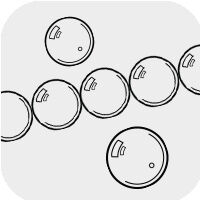Magnetite
Meaning and Properties
Magnetite History
Magnetite (not to be confused with magnesite) was originally called lodestone as early as 1548 and by other names such as magnetic hematite. Magnetite was given that name in 1845 by Wilhelm Karl von Haidinger because natural magnets (lodestones) were known to ancient Greeks, who called this mineral "magnet", where was found in the lands of the Magnetes (Magnesia) in Thessaly. Naturally-magnetized pieces of magnetite, called lodestone, will attract small pieces of iron, which is how ancient peoples first discovered the property of magnetism. Magnetite is a heavy material, black or brownish-black with a metallic luster. It is the most magnetic of all natural commonly occurring minerals on the Earth. The originally bright black color can gradually fade to dark brown via oxidation. Magnetite is often used in jewelry due to its supposed magnetic healing properties.
Magnetite is a rock mineral and, along with hematite, is mined as one of the main iron ores. Scientists have discovered evidence that magnetite exists in the human brain and have theorized its presence can affect long-term memory. Magnetite power was used by the Germans in the 1930s to develop magnetic acetate tape for audio recording. Magnetite is also the catalyst for the industrial synthesis of ammonia.
Magnetite Metaphysical Properties
Magnetite is believed to alleviate negative emotions such as fear, anger and grief while promoting positive qualities such as tenacity and endurance. Because magnetite has magnetic properties, it acts as a grounding stone and is thought to have powerful positive-negative polarity, meaning it attracts and repels, providing energy and a calming effect. Magnetite attracts love, commitment and loyalty. Magnetite is said to provide stability, balancing the intellect with the emotion as well as bringing a balanced perspective and trust in your own intuition. Magnetite is a base chakra stone, temporarily aligning the chakras, the subtle and etheric bodies and the gemstone is related to the astrological signs of Aries, Virgo, Capricorn and Aquarius.
Magnetite Geological Properties
Magnetite is a very common iron oxide mineral; hence it is a commonly mined ore of iron. Magnetite is found in igneous, metamorphic and sedimentary rocks. It is also the mineral with the highest amount of iron magnetite crystals, which typically occur when the earth's magma cools at a slow enough rate for crystals to form and settle outside the magma. Magnetite also occurs in banded iron formations and in lake and marine sediments.
Magnetite has been found in large quantities in beach sand. Such mineral sands (black sands or iron sands) are found in Hong Kong, California beaches and the west coast of the North Island of New Zealand. After it has eroded from rocks, the magnetite is washed to the beach by rivers and ocean waves/currents. Large deposits of magnetite are also found in Australia, Chile, Mauritania, Sweden, Uruguay and, most recently, in Peru. Deposits have been discovered in Norway, Germany, Italy, Switzerland, South Africa, India, Indonesia, Mexico, Hong Kong, and in Colorado, New Jersey, New Mexico, North Carolina, Oregon, Pennsylvania, Utah, Virginia and West Virginia in the United States.
|
|
|
|
|
|
|
|
|
|
|
|
|
|
|
|
|
|
Proper Care of Magnetite
Magnetite may form a yellow-brown rust coating if washed or kept in a moist area. If a stone is washed, it should be dried to prevent rusting. Rust can easily be removed by soaking the magnetite in a rust-removing solvent.
To learn more about magnetite and other gemstones, order your copy of Walter Schumann's revised and expanded edition of Gemstones of the World.
Designing with Magnetite
Often, magnetite beads are mixed with turquoise as they have a similar look when they are colored to match. Dyed white magnetite is an economical substitute for turquoise. It can be dyed vivid shades of turquoise blue, lime green or red with fantastic thick matrix patterns that texture the surface. Use large nuggets with antiqued sterling silver beads for a design with world cultural appeal.
View more resources featuring magnetite, including Design Ideas, Videos, Tutorials and more!
Shop for Magnetite
**Please note that all metaphysical or healing properties listed are collected from various sources. This information is offered as a service and not meant to treat medical conditions. Fire Mountain Gems and Beads® does not guarantee the validity of any of these statements.
How did you like this resource? Your feedback helps us provide resources that matter to you most.
Copyright Permissions
All works of authorship (articles, videos, tutorials and other creative works) are from the Fire Mountain Gems and Beads® Collection, and permission to copy is granted for non-commercial educational purposes only. All other reproduction requires written permission. For more information, please email copyrightpermission@firemtn.com.

